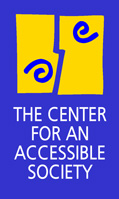
DISABILITY
ISSUES
INFORMATION
FOR
JOURNALISTS
TOPICS
ABOUT
THE CENTER
Posted March, 1999
The U.S. Supreme Court hears oral arguments in April on four cases whose outcomes will profoundly shape not only the nature of the Americans with Disabilities Act but of our country's very understanding of what it means to be a "person with a disability."
"We are at a critical point," says Matthew Diller, associate professor of law at Fordham University who has written on Social Security Disability law. "By July, either all these problems will have been corrected, or the ADA will become a very narrow law."
Three of the four cases examine what "disability" means under the ADA and in the context of work, said Diller. The other asks "whether a person getting disability benefits can even sue under the employment provisions of the ADA": The reasoning here, says Diller, is that if you're getting benefits, that's tantamount to admitting that you can't work -- so it's a moot point that you're being discriminated against in employment, since you've already admitted you can't work!
"These are terrible cases," he says.
"Several years ago, we all started saying that disabled people were losing an awful lot of ADA cases," said Linda Krieger, assistant professor of law at Boalt Hall who organized a meeting there in March, 1999, bringing together disability lawyers and academics to discuss the problem. What was particularly troubling, she said, was that disabled people were losing cases in the courts of judges "who were very liberal on other civil rights issues."
Judges were stopping the cases before they even got started, telling people they weren't "disabled" as the ADA defined it, "and that they therefore didn't have a right to use the law at all," said Krieger.
Unlike the Civil Rights Act of 1964, which "came after a tremendous amount of mass consciousness-raising about race and racism, the ADA passed with very little understanding of what disability discrimination really is, said Krieger. The ADA is "was based on a socio-cultural model of disability that judges don't understand," said Krieger.
"Judges operate from an 'impairment model' or a "social welfare/benefits' model. They keep asking whether the plaintiff is 'sufficiently impaired' to 'deserve protection" under the ADA."
The Americans with Disabilities Act -- and the disability rights movement that spawned it -- has at its core "a central premise both simple and profound": that people called "disabled" by society are just people -- not different in any critical way from other people," said law professor Bob Burgdorf.
Burgdorf, who worked at the U.S. Commission on Civil Rights in the 1980s when the ADA was just a gleam in activists' eyes, was responsible for a Commission report that formed the philosophical underpinning of the law.
Yet the courts, with what he calls "manifestly good intentions," have interpreted and applied the law in ways "that reinforce a diametrically opposite premise." In a 1997 Villanova Law Review article, "'Substantially limited' Protection from Disability Discrimination: The Special Treatment Model and Misconstructions of the Definition of Disability," Burgdorf decried what he called the "special class" and "preferential treatment" mentality that has crept into the interpretation and enforcement of a law designed to ensure equality and integration.
"Legal analysis has proceeded quite a long way down the wrong road," he said.
"Though we are conditioned to think otherwise, human beings do not really exist in two sharply distinct groups of 'people with disabilities' and 'those without disabilities,'" Burgdorf said, echoing what he wrote the 1985 U.S. Commission on Civil Rights report, "Accommodating the Spectrum of Individual Abilities."
Disability is "a natural part of the human condition resulting from that spectrum - "and will touch most of us at one time or another in our lives.
"The goal is not to fixate on, overreact to or engage in stereotypes about such differences -- but to take them into account" and allow for "reasonable accommodation for individual abilities and impairments that will permit equal participation."
This, he said, is the real goal of the ADA. -- to "provide equal opportunities for all Americans" -- not to "identify a particular group of individuals who are entitled to some kind of special treatment."
While the civil rights model has had some positive effects for the disability rights movement, said Krieger, it has come with baggage as well: in legal thought, "equal rights" equates with "equal treatment."
The ADA presents a set of new ideas for people. "It's particularly hard for people to understand the idea of "equality" behind the ADA, said Diller -- that people have to, in fact, be treated differently sometimes in order to achieve equal rights.
To many judges, this seems akin to affirmative action or the "special rights" charge that is leveled by conservatives against all manner of efforts to extend social justice.
"If anyone thought the disability movement's work was finished with the passage of the ADA" they are very very wrong, Diller said. "Disability rights holds the power to change the trajectory toward a cookie-cutter society," he said. It has the potential "to transform society itself."
To do that, though, "disability" itself must first be understood.
Overview
From the Disability and Business Technical Assistance Centers:
The ADA is changing the landscape of America -- commentary
"The ADA changed my life" -- personal stories
The meaning of "disability" under ADA
"A misunderstood law" -- commentary
Supreme Court ADA decisions: